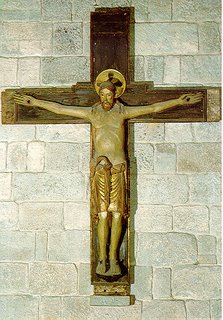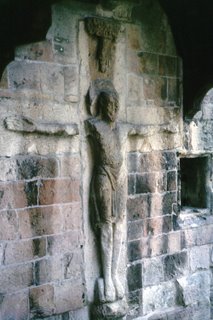

Christus Triumphans--Another entry on early Christian art
From the Oxford Dictionary of Christian Art:
An ". . .important point about the two early representations (of the crucifixion) is that the figure of Christ is standing against, rather than hanging from, the cross. He wears only a loin-cloth and is fastened by four nails, but is triumphing over death rather than dying. This emphasis on victory, not on agonizing death, is characteristic of all the earliest representations, as Christus Triumphans."
3 comments:
I'm not sure who "owns" the rights to the content (Abp. Cranmer penned most of it; all of the editions are simply reordering of his work; Coverdale did the Psalter). Anyone, I think, could offer a version identical to the 1928 in content.
Along those lines, the Reformed Episcopal BCP has taken the 1928 BCP and added the 1662 Communion and inserted a few "new" elements into it (impositions of ashes, Creed of St. Athanasius, etc). They do have a leather edition available.
The Anglican Parishes Association of the Anglican Catholic Church publishes some nice red hardbound editions of the 1928 with either an "Anglican Catholic" title page or a "neutral" page (in either case, no mention of the now defunct "Protestant Episcopal Church"). However, to my knowledge, no leather editions.
I'm surprised to hear that the Oxford leather 28 is no longer available--I haven't checked Amazon in a while on that matter. Perhaps they'll bring it back. If not, there's a good chance that the Prayer Book Society might be interested in something like that, in that they've published the new 1928 Altar edition.
AC+
Check with CBD (www.christianbook.com) for leather covered 1928 BCP.
MLW+
As an artist, I appreciate the creativity of the "Christus Rex" image, as well as its theological message, much in the same way I appreciate an image of Jesus Christ in eucharistic vestments. It says something true in an interesting, creative way.
I think that a crucifix is obviously more accurate historically. Crucifixion was brutal, and the one being killed that way hung there, dripping blood. To portray Christ on the cross, if one wants to be historically accurate, is to portray Him rather gruesomely, I'm afraid.
That said, I have to admit, though, that I am somewhat ambivelant about whether that, a cross, or a crucifix is used in a church. At St. Mark's we have all three (in different places, obviously).
Post a Comment